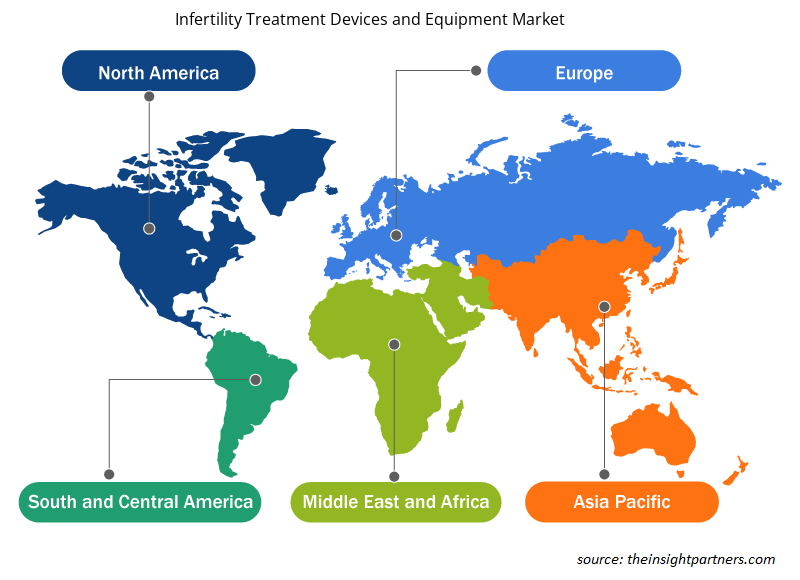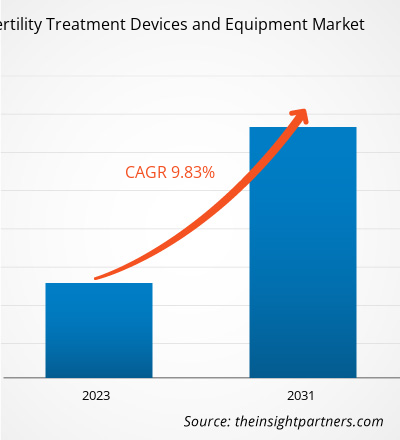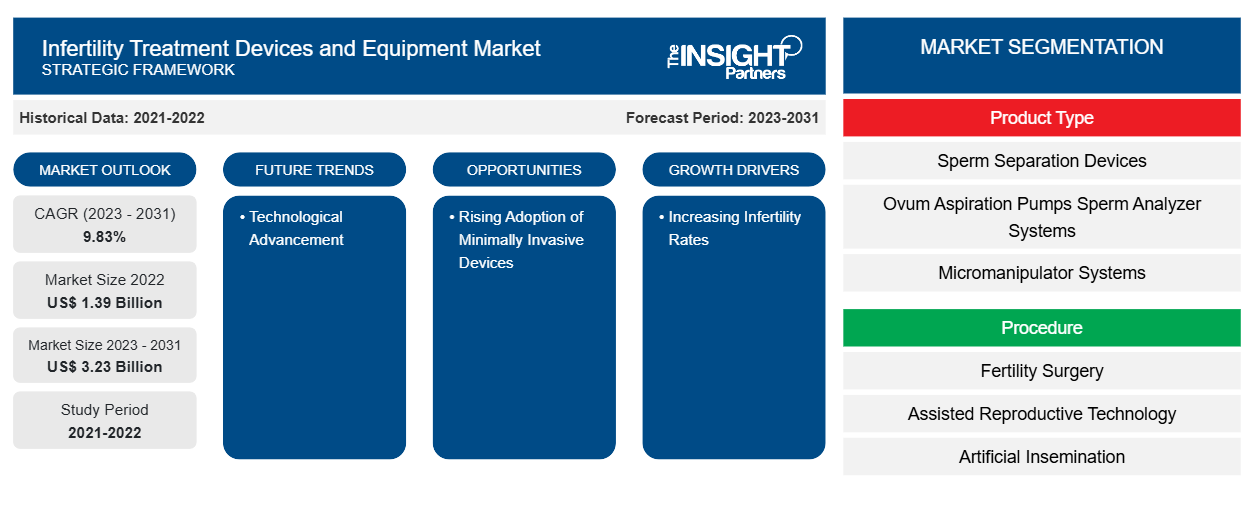La taille du marché des dispositifs et équipements de traitement de l'infertilité devrait atteindre 3,23 milliards USD d'ici 2031, contre 1,39 milliard USD en 2022. Le marché devrait enregistrer un TCAC de 9,83 % en 2023-2031. Le développement de nouveaux traitements contre l'infertilité, tels que l'injection intracytoplasmique de spermatozoïdes, devrait rester l'une des principales tendances du marché des dispositifs et équipements de traitement de l'infertilité.
Analyse du marché des dispositifs et équipements de traitement de l'infertilité
L'infertilité est l'incapacité de concevoir après un an de rapports sexuels non protégés. L'Organisation mondiale de la santé (OMS) l'a reconnue comme un problème de santé publique. Le marché mondial des dispositifs et équipements de traitement de l'infertilité connaît une croissance significative en raison de divers facteurs, notamment la baisse du taux de fécondité mondial, le taux de réussite plus élevé des technologies de reproduction avancées et le soutien croissant du gouvernement et d'autres organismes de santé. Ces facteurs devraient favoriser le développement de nouveaux traitements pour améliorer la fertilité.
Aperçu du marché des dispositifs et équipements de traitement de l'infertilité
Selon l’OMS, près de 17,5 % des adultes dans le monde souffrent d’infertilité. La prévalence de cette maladie au cours de la vie est de 17,8 % dans les pays à revenu élevé et de 16,5 % dans les pays à revenu faible et intermédiaire. L’augmentation des cas d’infertilité entraîne une augmentation du nombre de patients qui recherchent des traitements contre l’infertilité. Cela met en évidence la nécessité de soins de fertilité abordables et de haute qualité, ce qui contribue à l’expansion du marché des dispositifs et équipements de traitement de l’infertilité.
Personnalisez ce rapport en fonction de vos besoins
Vous bénéficierez d'une personnalisation gratuite de n'importe quel rapport, y compris de certaines parties de ce rapport, d'une analyse au niveau des pays, d'un pack de données Excel, ainsi que de superbes offres et réductions pour les start-ups et les universités.
- Obtenez les principales tendances clés du marché de ce rapport.Cet échantillon GRATUIT comprendra une analyse de données, allant des tendances du marché aux estimations et prévisions.
Moteurs et opportunités du marché des dispositifs et équipements de traitement de l'infertilité
Les taux de réussite élevés des technologies avancées de traitement de l'infertilité devraient favoriser le marché
Les traitements de procréation médicalement assistée ont considérablement progressé, élargissant les options et les taux de réussite des traitements contre l’infertilité tels que la technologie de procréation assistée (ART). Selon un article publié dans Cureus en octobre 2022, dans les années à venir, la FIV devrait être largement utilisée dans plusieurs régions du monde, conduisant à la naissance de jusqu’à 10 % de tous les enfants et les taux de réussite de la maturation in vitro (IVM) ont augmenté jusqu’à 56 % en raison des progrès technologiques, de l’amélioration des outils nécessaires et de l’expérience et de la formation accumulées de ceux qui effectuent la procédure. En outre, les méthodes de connaissance de la fertilité, comme les applications de suivi de l’ovulation , sont devenues plus accessibles et plus fiables, permettant de prendre des décisions éclairées en matière de planification familialeCureus in October 2022, in the coming years, IVF is anticipated to be widely used across multiple regions globally, leading to the birth of up to 10% of all children and the success rates of In vitro maturation (IVM) have increased up to 56% due to technological advancements, improved necessary tools, and the accumulated experience and training of those performing the procedure. In addition, fertility awareness methods, like ovulation
Dispositifs mini-invasifs – Une opportunité dans le traitement de l’infertilité
Plusieurs anomalies et pathologies, notamment les fibromes utérins, les anomalies müllériennes, les kystes ovariens et l’endométriose, peuvent réduire les chances de grossesse. Ces problèmes peuvent également entraîner des effets secondaires désagréables, notamment des douleurs pelviennes chroniques et des saignements abondants. L’intervention chirurgicale peut être le traitement le plus efficace pour ces symptômes dans de tels cas. L’adoption de techniques mini-invasives telles que la laparoscopie et l’hystéroscopie peut traiter la cause sous-jacente de l’infertilité en réduisant la douleur, le temps de récupération, le risque d’infection et la perte de sang. Ces procédures impliquent l’utilisation de petites incisions et de caméras haute définition qui projettent la zone d’opération sur un moniteur plutôt que de grandes incisions ouvertes utilisées dans les chirurgies conventionnelles.
Analyse de segmentation du rapport sur le marché des dispositifs et équipements de traitement de l'infertilité
Les segments clés contribuant à la dérivation des dispositifs et équipements de traitement de l’infertilité L’analyse du marché est le type de produit, la procédure et l’utilisateur final.
- En fonction du type de produit, le marché des dispositifs et équipements de traitement de l'infertilité est divisé en dispositifs de séparation des spermatozoïdes, pompes d'aspiration d'ovules, systèmes d'analyse des spermatozoïdes, systèmes de micromanipulation, incubateurs et autres. Le segment des pompes d'aspiration d'ovules détenait la plus grande part de marché en 2023.
- En termes de procédure, le marché est segmenté en technologies de procréation assistée, chirurgie de fertilité et insémination artificielle. Le segment de l'insémination artificielle détenait la plus grande part de marché en 2023. En outre, le segment des technologies de procréation assistée devrait enregistrer le TCAC le plus élevé de 2023 à 2031.
- En termes d'utilisateur final, le marché est segmenté en cliniques de fertilité, hôpitaux et autres établissements de santé et instituts de recherche clinique. Le segment des cliniques de fertilité a dominé le marché en 2023.
Analyse des parts de marché des dispositifs et équipements de traitement de l'infertilité par zone géographique
La portée géographique du rapport sur le marché des dispositifs et équipements de traitement de l'infertilité est principalement divisée en cinq régions : Amérique du Nord, Asie-Pacifique, Europe, Moyen-Orient et Afrique, et Amérique du Sud et centrale.
L'Amérique du Nord domine le marché des dispositifs et équipements de traitement de l'infertilité. Selon le ministère américain de la Santé et des Services sociaux, en 2021, environ 2,3 % des nourrissons nés aux États-Unis ont été conçus à l'aide de la procréation médicalement assistée (ART), avec environ 413 776 cycles effectués dans 453 cliniques, donnant lieu à 112 088 grossesses. Le nombre croissant de procédures AR telles que la FIV, les taux croissants d'infertilité chez les hommes et la présence d'acteurs du marché mondial sont des facteurs contribuant à la domination du marché nord-américain des dispositifs et équipements de traitement de l'infertilité. L'Asie-Pacifique devrait connaître le TCAC le plus élevé dans les années à venir.
Aperçu régional du marché des dispositifs et équipements de traitement de l'infertilité
Les tendances et facteurs régionaux influençant le marché des dispositifs et équipements de traitement de l’infertilité tout au long de la période de prévision ont été expliqués en détail par les analystes d’Insight Partners. Cette section traite également des segments et de la géographie du marché des dispositifs et équipements de traitement de l’infertilité en Amérique du Nord, en Europe, en Asie-Pacifique, au Moyen-Orient et en Afrique, ainsi qu’en Amérique du Sud et en Amérique centrale.

- Obtenez les données régionales spécifiques au marché des dispositifs et équipements de traitement de l'infertilité
Portée du rapport sur le marché des dispositifs et équipements de traitement de l'infertilité
| Attribut de rapport | Détails |
|---|---|
| Taille du marché en 2022 | 1,39 milliard de dollars américains |
| Taille du marché d'ici 2031 | 3,23 milliards de dollars américains |
| Taux de croissance annuel composé mondial (2023-2031) | 9,83% |
| Données historiques | 2021-2022 |
| Période de prévision | 2023-2031 |
| Segments couverts | Par type de produit
|
| Régions et pays couverts | Amérique du Nord
|
| Leaders du marché et profils d'entreprises clés |
|
Densité des acteurs du marché des dispositifs et équipements de traitement de l'infertilité : comprendre son impact sur la dynamique commerciale
Le marché des dispositifs et équipements de traitement de l'infertilité connaît une croissance rapide, tirée par la demande croissante des utilisateurs finaux en raison de facteurs tels que l'évolution des préférences des consommateurs, les avancées technologiques et une plus grande sensibilisation aux avantages du produit. À mesure que la demande augmente, les entreprises élargissent leurs offres, innovent pour répondre aux besoins des consommateurs et capitalisent sur les tendances émergentes, ce qui alimente davantage la croissance du marché.
La densité des acteurs du marché fait référence à la répartition des entreprises ou des sociétés opérant sur un marché ou un secteur particulier. Elle indique le nombre de concurrents (acteurs du marché) présents sur un marché donné par rapport à sa taille ou à sa valeur marchande totale.
Les principales entreprises opérant sur le marché des dispositifs et équipements de traitement de l'infertilité sont :
- Thermo Fisher Scientific
- Groupe de cuisiniers
- Vitrolife
- FIVtech APS
- Hamilton Thorne Ltée.
- Esco Micro Pte Ltd
Avis de non-responsabilité : les sociétés répertoriées ci-dessus ne sont pas classées dans un ordre particulier.

- Obtenez un aperçu des principaux acteurs du marché des dispositifs et équipements de traitement de l'infertilité
Actualités et développements récents du marché des dispositifs et équipements de traitement de l'infertilité
Le marché des dispositifs et équipements de traitement de l'infertilité est évalué en collectant des données qualitatives et quantitatives après des recherches primaires et secondaires, qui comprennent d'importantes publications d'entreprise, des données d'association et des bases de données. Voici une liste des évolutions du marché des dispositifs et équipements de traitement de l'infertilité :
- Trajan Scientific and Medical a fourni des dispositifs Mitra homologués CE-IVD à Fertilly, une start-up allemande. Fertilly a lancé les premiers kits de test de fertilité à domicile en Europe utilisant le microéchantillonnage de sang séché avec la technologie VAMS. Les dispositifs de microéchantillonnage Mitra permettent de collecter rapidement et facilement des échantillons de sang par piqûre au doigt, qui peuvent ensuite être envoyés par courrier à un laboratoire pour être analysés sous forme de sang séché. (Source : Trajan Scientific Australia Pty Ltd, communiqué de presse, 2023)
- Merck Specialties Pvt Ltd, la division santé de Merck en Inde, a lancé le stylo Pergoveris pour le traitement avancé de l'infertilité en Inde. Ce lancement souligne la volonté de l'entreprise de répondre aux besoins médicaux non satisfaits en proposant une option de traitement combiné améliorée, pratique et prête à l'emploi pour les femmes souffrant d'un déficit sévère en hormone folliculo-stimulante (FSH) et en hormone lutéinisante (LH). (Source : Merck Specialties Pvt Ltd, Communiqué de presse, 2021)
Rapport sur le marché des dispositifs et équipements de traitement de l'infertilité : couverture et livrables
Le rapport « Taille et prévisions du marché des dispositifs et équipements de traitement de l’infertilité (2021-2031) » fournit une analyse détaillée du marché couvrant les domaines ci-dessous :
- Taille du marché et prévisions aux niveaux mondial, régional et national pour tous les segments de marché clés couverts par le périmètre
- Dynamique du marché, comme les facteurs moteurs, les contraintes et les opportunités clés
- Principales tendances futures
- Analyse détaillée des cinq forces de PEST/Porter et SWOT
- Analyse du marché mondial et régional couvrant les principales tendances du marché, les principaux acteurs, les réglementations et les développements récents du marché
- Analyse du paysage industriel et de la concurrence couvrant la concentration du marché, l'analyse de la carte thermique, les principaux acteurs et les développements récents
- Profils d'entreprise détaillés
- Analyse historique (2 ans), année de base, prévision (7 ans) avec TCAC
- Analyse PEST et SWOT
- Taille du marché Valeur / Volume - Mondial, Régional, Pays
- Industrie et paysage concurrentiel
- Ensemble de données Excel
Rapports récents
Témoignages
Raison d'acheter
- Prise de décision éclairée
- Compréhension de la dynamique du marché
- Analyse concurrentielle
- Connaissances clients
- Prévisions de marché
- Atténuation des risques
- Planification stratégique
- Justification des investissements
- Identification des marchés émergents
- Amélioration des stratégies marketing
- Amélioration de l'efficacité opérationnelle
- Alignement sur les tendances réglementaires





















 Obtenez un échantillon gratuit pour - Marché des dispositifs et équipements de traitement de l'infertilité
Obtenez un échantillon gratuit pour - Marché des dispositifs et équipements de traitement de l'infertilité